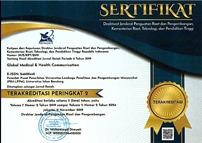Autism Spectrum Disorder: a Two-center Evaluation of Pharmacological Intervention and Behavioral Therapies on Core Symptoms
Abstract
Keywords
Full Text:
PDFReferences
American Psychiatric Association. Diagnostic and statistical manual of mental disorders. 5th Edition. Arlington: American Psychiatric Publishing; 2013.
Shrestha M, Basukala S, Thapa N, Shrestha O, Basnet M, Shrestha K, et al. Prevalence of autism spectrum disorder among children in Southeast Asia from 2002 to 2022: an updated systematic review and meta-analysis. Health Sci Rep. 2024;7(4):e2005.
Rosen NE, Lord C, Volkmar FR. The diagnosis of autism: from Kanner to DSM-III to DSM-5 and beyond. J Autism Dev Disord. 2021;51(12):4253–70.
Moulton E, Bradbury K, Barton M, Fein D. Factor analysis of the Childhood Autism Rating Scale in a sample of two year olds with an autism spectrum disorder. J Autism Dev Disord. 2019;49(7):2733–46.
Robertson CE, Baron-Cohen S. Sensory perception in autism. Nat Rev Neurosci. 2017;18(11):671–84.
Patil O, Kaple M. Sensory processing differences in individuals with autism spectrum disorder: a narrative review of underlying mechanisms and sensory-based interventions. Cureus. 2023;15(10):e48020.
Narzisi A, Fabbri-Destro M, Crifaci G, Scatigna S, Maugeri F, Berloffa S, et al. Sensory profiles in school-aged children with autism spectrum disorder: a descriptive study using the Sensory Processing Measure-2 (SPM-2). J Clin Med. 2022;11(6):1668.
Reichow B, Hume K, Barton EE, Boyd BA. Early intensive behavioral intervention (EIBI) for young children with autism spectrum disorders (ASD). Cochrane Database Syst Rev. 2018;5(5):CD009260.
VanDerwall R, Rotta K, Ehrhardt K, Poling A. Using aripiprazole to benefit people with autism spectrum disorder: a critical appraisal. Adv Neurodev Disord. 2021;5(1):1–10.
Sari SH. Childhood autism: the internal consistency Childhood Autism Rating Scale for use in Indonesia and descriptive study of autism clinical variance [undergraduate thesis]. Semarang: Universitas Diponegoro; 2009. Available from: http://eprints.undip.ac.id/7487/1/Stefani_harum_sari.pdf.
Otsuka Pharmaceutical Company. Highlights of prescribing information [Internet]. Tokyo: Otsuka Pharmaceutical Company; 2016 [cited 2024 September 20]. Available from: https://www.accessdata.fda.gov/drugsatfda_docs/label/2016/021436s041%2C021713s032%2C021729s024%2C021866s026lbl.pdf.
Chand R, Sharma A, Chaudhary S. Saccharum lactis a placebo or homoeopathic medicine: a mystery vehicle. Homoeopath Herit. 2024;50(4):14–6.
Slocum TA, Detrich R, Wilczynski SM, Spencer TD, Lewis T, Wolfe K. The evidence-based practice of applied behavior analysis. Behav Anal. 2014;37(1):41–56.
Jurek L, Baltazar M, Gulati S, Novakovic N, Núñez M, Oakley J, et al. Response (minimum clinically relevant change) in ASD symptoms after an intervention according to CARS-2: consensus from an expert elicitation procedure. Eur Child Adolesc Psychiatry. 2022;31(8):1–10.
Ichikawa H, Mikami K, Okada T, Yamashita Y, Ishizaki Y, Tomoda A, et al. Aripiprazole in the treatment of irritability in children and adolescents with autism spectrum disorder in Japan: a randomized, double-blind, placebo-controlled study. Child Psychiatry Hum Dev. 2017;48(5):796–806.
Rizzo R, Pavone P. Aripiprazole for the treatment of irritability and aggression in children and adolescents affected by autism spectrum disorders. Expert Rev Neurother. 2016;16(8):867–74.
Marcus RN, Owen R, Manos G, Mankoski R, Kamen L, McQuade RD, et al. Aripiprazole in the treatment of irritability in pediatric patients (aged 6–17 years) with autistic disorder: results from a 52-week, open-label study. J Child Adolesc Psychopharmacol. 2011;21(3):229–36.
Fung LK, Chahal L, Libove RA, Bivas R, Hardan AY. A retrospective review of the effectiveness of aripiprazole in the treatment of sensory abnormalities in autism. J Child Adolesc Psychopharmacol. 2012;22(3):245–8.
Frazier TW, Youngstrom EA, Haycook T, Sinoff A, Dimitriou F, Knapp J, et al. Effectiveness of medication combined with intensive behavioral intervention for reducing aggression in youth with autism spectrum disorder. J Child Adolesc Psychopharmacol. 2010;20(3):167–77.
Chung KM, Chung E, Lee H. Behavioral interventions for autism spectrum disorder: a brief review and guidelines with a specific focus on applied behavior analysis. Soa Chongsonyon Chongsin Uihak. 2024;35(1):29–38.
Hara Y, Ago Y, Taruta A, Hasebe S, Kawase H, Tanabe W, et al. Risperidone and aripiprazole alleviate prenatal valproic acid-induced abnormalities in behaviors and dendritic spine density in mice. Psychopharmacology (Berl). 2017;234(21):3217–28.
Alsayouf HA, Talo H, Biddappa ML, De Los Reyes E. Risperidone or aripiprazole can resolve autism core signs and symptoms in young children: case study. Children (Basel). 2021;8(5):318.
Khaledi H, Aghaz A, Mohammadi A, Dadgar H, Meftahi GH. The relationship between communication skills, sensory difficulties, and anxiety in children with autism spectrum disorder. Middle East Curr Psychiatry. 2022;29:69.
Wong C, Odom SL, Hume KA, Cox AW, Fettig A, Kucharczyk S, et al. Evidence-based practices for children, youth, and young adults with autism spectrum disorder: a comprehensive review. J Autism Dev Disord. 2015;45(7):1951–66.
Tiura M, Kim J, Detmers D, Baldi H. Predictors of longitudinal ABA treatment outcomes for children with autism: a growth curve analysis. Res Dev Disabil. 2017;70:185–97.
Politte LC, Howe Y, Nowinski L, Palumbo M, McDougle CJ. Evidence-based treatments for autism spectrum disorder. Curr Treat Options Psychiatry. 2015;2:38–56.
Odermatt SD, Möhring W, Grieder S, Grob A. Cognitive and developmental functions in autistic and non-autistic children and adolescents: evidence from the intelligence and development scales–2. J Intell. 2022;10(4):112.
pISSN 2301-9123 | eISSN 2460-5441
Visitor since 19 October 2016:
Global Medical and Health Communication is licensed under a Creative Commons Attribution-NonCommercial-ShareAlike 4.0 International License.






























.png)
_(1).png)
_(1).jpg)
